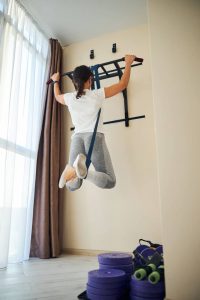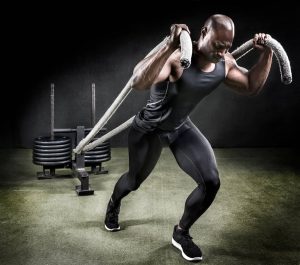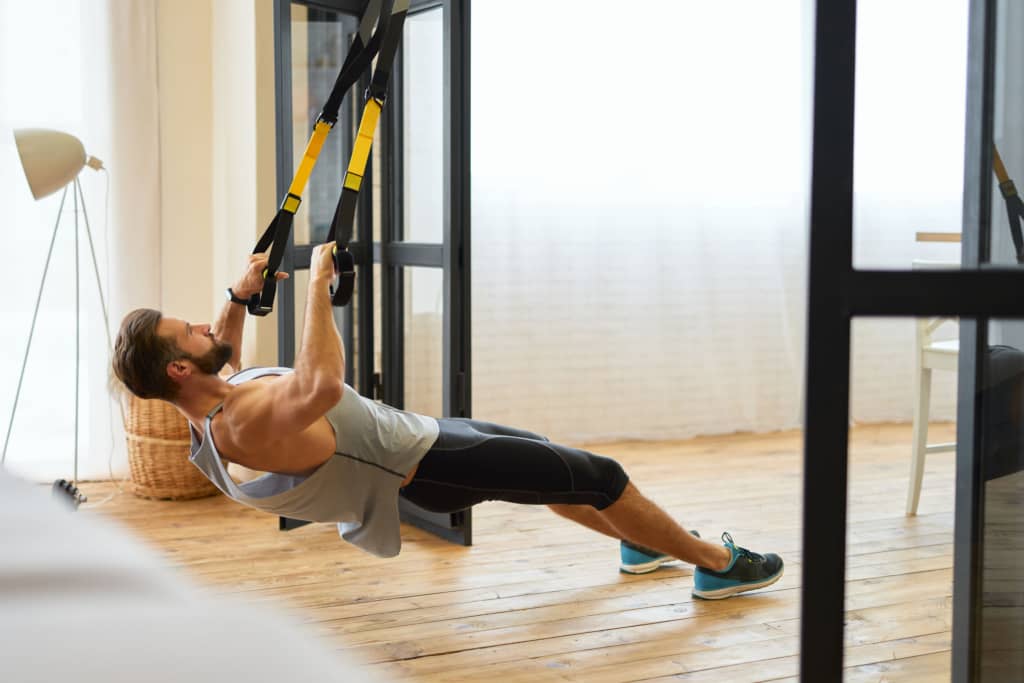Pull Exercises
The pull exercises require lifting up against your own weight while clutching a rod or bar with your hands. This is a strength training exercise that can be used to develop muscle and increase upper-body strength. The most common drawback of pull exercise is its difficulty. Just doing one pull of the workout can be difficult for beginners.
A person needs to lift his or her body weight against gravity all through the exercise thereby putting tension on the body muscles. The muscles in the arms and back strengthen as a result of this tension.
However, here’s a list of the best pull exercises for muscular and body strength gain to get you started even as a beginner.
15 List of Best Pull Exercises
Each pull exercise here involves pulling from one of your pulling muscles, such as your biceps, back, or forearms.
Deadlifts
Deadlifts strengthen the calves, hamstrings, glutes, and upper back muscles.
How to do proper deadlifts:
Place the weighted hammer in front of you on the floor.
As you face the bar, ensure your feet are shoulder-width away. Place your feet directly beneath the bar in the center.
Your upper body swings forward as you push your hips back and gently bend your knees.
Hold the bar with both hands overhand. Make sure your back is not arched but is straight.
Once you’re set, breathe and pull your hips forward to stand straight and lift the weight up to your hips.
Maintain a smooth movement throughout the exercise and immediately begin the following round. Continuing the process, two to three sets of six to ten rounds are recommended.
Dumbbell rows
Dumbbell rows target the trapezius, triceps, latissimus dorsi, and deltoid muscle. It’s best to do rows using a dumbbell, although a kettlebell can also be used.
How to do a proper dumbbell row:
Stand with your feet hip-width apart and a dumbbell in one hand.
Tilt your hips forward until your chest is almost lateral to the floor.
Allow the weight to dangle under the chest, with the palm facing in towards the body’s midsection.
Lift the weight up to the chest while keeping the core tight.
Your elbow will rise against the ceiling as you draw up.
Keep the arm tight to the ribcage as you drop it to the original posture.
Bent-over rows
Bent-over rows work both the latissimus dorsi and the biceps and can be done using a barbell or dumbbells.
How to do a proper bent-over row:
In front of you, put a weighted barbell on the floor. Keep your legs below the barbell as you near it.
Push your hips back and gently tilt your knees in a way that your upper torso is nearly lateral to the floor.
With your hands more than a shoulder-width spread, grab the barbell with a pronated grip.
Lift the barbell into your chest area by pressing your shoulder blades closely and pushing your elbows straight to the back.
Contract your biceps at the top, then gently stretch your arms by releasing your bent elbow.
Each round does not require you to lower the barbell to the floor. Instead, stretch your arms until the barbell rests against your shins.
Single-arm dumbbell rows
Single-arm dumbbell rows are a great way to engage your backsides, such as the latissimus dorsi, trapezius, rhomboids, teres major, and minor.
How to do proper single-arm dumbbell rows:
Keep your left knee on a flat bench and carry a dumbbell in your right hand.
To position your left palm firmly on the flat bench, tilt forth your upper body.
Ensure that your hand is positioned just beneath your left shoulder.
Bring your right elbow back while pulling your shoulders back and down.
The dumbbell will rise to your chest level. As you lift the dumbbell upwards, avoid twisting your upper body.
At the peak of the pull, contract your back muscles, then gently return your arm to the original posture.
Dumbbell Pullover
A dumbbell pullover engages the chest and lats. It’s a perfect pull exercise to improve body posture. It stretches the spine by extending the arms overhead.
How to do proper single-arm dumbbell rows:
Face up on a flat bench with both hands holding one dumbbell each.
Gently relax on the bench and lift each dumbbell to your chest.
Your elbows will only be slightly bent, and your back must be straight.
Gradually lift the dumbbells over your head while maintaining straight arms.
At the peak of the pull, tighten your torso and back muscles. Then, carefully lower the dumbbells from overhead to above your chest.
6. Lat Pulldowns
The latissimus dorsi is the largest of the back muscles. It almost fully covers the center and lower back. One of the best workouts for the latissimus dorsi is the lat pulldown. If you desire a strong back, the lat pulldowns exercise should become your first target.
Before you begin the exercise:
You must first arrange the pulldown machine.
Take a seat in the chair and reach up to hold the bar.
While seated flat on the seat, you should be able to reach up and grip it overhand with almost complete straight arms.
Get the bar in the right position by adjusting the cable length.
Next, set the thigh pad while sitting back in the chair. It should secure your legs to the chair.
After you’ve completed all these, it’s time to do the lat pulldowns.
How to do proper lat pulldowns:
Sit in the chair, tuck your thighs beneath the thigh pad, and stretch to hold the pulldown bar.
Breathe and push your shoulders back together to draw the bar down to your chin.
Now at the bottom, tighten your back muscles. Then gradually begin to release the bar to return to the original position.
7. Kettlebell Renegade Rows
The kettlebell renegade row is a combination of a plank and a row that targets two muscle groups. The cores and lower body are worked in the plank, while the back and shoulders are worked in the row. It’s also a perfect activity for a complete body exercise.
How to do proper kettlebell renegade rows:
Take two kettlebells that are the same size.
Kneel down and set the kettlebells directly to face you.
Hold both kettlebells overhand. Kettlebells must be positioned just below your shoulders.
Hold onto the kettlebell handles, and squeeze yourself into a plank position.
Then, raise the kettlebell from the floor by pressing your weight into your left hand, bracing your abs, and pushing your right elbow back.
Contract your abs and back, then gradually let go of your elbow and return the kettlebell to its initial position.
8. Bicep Curls
The ideal exercise for biceps development is bicep curls. Bicep curls engage not only the biceps but also the two muscles in the antebrachium.
How to do proper bicep curls:
Stand straight with your feet shoulder-width apart and grip one dumbbell in each hand, palms facing forward.
Allow your arms to hang lifeless, but keep your shoulders from rolling forward.
Coil the dumbbells up towards your shoulders.
Throughout the exercise, put your elbows locked by your sides.
At the apex of the bend, tighten your biceps, then gradually return to the initial position.

9. Leg curls
Leg curls work the calf muscles, glutes, quads, and shins in addition to the hamstring. The most common way to perform this pull exercise is to use a leg curl machine at the gym.
How to do proper leg curls in the gym:
Rest your face on the flat bench.
Ensure the roller pad is positioned between your calves and heels above your lower leg.
Twisting the knee, squeeze the hamstring and raise the feet to your glutes.
Ensure your hips are in touch with the bench.
Continue the process with the feet slowly returning to the beginning position.
10. Pull-ups
One of the most common bodyweight workouts is pull-ups. They target key muscles like the lats, biceps, deltoids, and rhomboids.
How to do proper pull-ups:
Jump and grab a pull-up bar with a wide overhand grip while standing right under it. Your hands must be wider than shoulder-width apart.
To elevate your chin above the pull-up bar, push your shoulders back and down. To lift your torso, your elbows must be lowered.
At the apex, tighten your muscles, then gradually relax and return to a flat hang.

11. Barbell shrugs
Barbell shrugs are a type of pull exercise that targets the shoulders. The shoulder muscles are more of a push than a pull muscle.
Barbell shrugs are small movement that has a huge impact on your upper back and core muscles. Although they appear to be simple, they involve a great deal of core support. As a result, you have the benefit of developing broad shoulders and a strong core.
How to do proper barbell shrugs:
In front of you, set a barbell on the ground. Reach the bar and place your feet in the middle of it.
To make your upper body swing forward, push your hips back and gently tilt your knees.
Using an overhand hold, bend down and hold the bar. Your hands ought to be beyond your knees.
Let your arms fall straight down and push your hips forward to stand straight like you were doing a deadlift. Avoid letting the barbell’s weight slouch your shoulders forward.
Raise your shoulder blades for a few seconds.
Take a deep breath and return your shoulder blades to their original posture. Ensure your back is in a straight position.
12. Cable face pulls
Push workouts that stress the upper body can be replaced with cable face pulls. The top rear chain muscles, which comprise the upper back, rear deltoids, trapezius, as well as the biceps, are engaged by the cable face pull. Add the cable face pulls to your exercise routine if you desire a broader upper body.
Before performing this pull exercise, you need to set your cable machine.
Connect the cord to the dual rope connector.
Then adjust the pulley’s height to the highest point on the cable machine.
You can be creative with a resistance band if you’re performing a home workout and don’t have access to a machine.
How to do proper cable face pulls:
Walk a few steps back from the cable machine, holding one end of the rope with both hands, until your arms are straight and the cable is tight. Do not roll your shoulders forward.
Using your deltoids, pull the rope ends up to your forehead. Your elbows should be outstretched and your palms should be facing front.
Contract your muscles, then gently loosen them and return your arms to a straight position without moving your shoulders forward.
13. T-bar rows
T-bar rows are a little easier on the lower back than the standard barbell shrugs or bent-over rows. You can however change the grip of the T-bar row to focus on specific areas of your back. As a result, they’re a common back and shoulder exercise.
If you don’t have a T-bar machine, you can do T-bar rows by binding the tip of a barbell to one side.
How to do proper T-bar rows:
Stand on one side of the T-bar row bench with one foot on each side of the bar. Place your feet between the shoulder and hip-width gap.
Slowly tilt your knees and lean forth from your hips, keeping your feet flat. Maintain a small arch in your back.
Take both hands and grab the handles. Raise the weight keeping your arms straight till your chest is about 45 degrees and lateral to the floor.
Draw the handle towards your chest by twisting your arms. Maintain straight wrists and follow with your elbows. Allowing your lower back to round is not a good idea.
Stretch your arms completely and repeat the process.
14. Pendlay rows
Dead stop barbell rows are another name for pendlay rows. It was named after Glen Pendlay, a weightlifting coach. The latissimus dorsi, middle trapezius, rhomboids, posterior deltoids, biceps brachii, and lower back muscles are all worked out during pendlay rows. Pendlay rows also target your legs, glutes, and core muscles. These muscles support your body and keep you in place.
How to do proper Pendlay rows:
Begin by placing your barbell on the ground. Stand with feet apart and your toes underneath the bar.
Lean forward from the hips and tilt over until your entire torso is perfectly straight, and your knees somewhat arched.
Ensure that your lower back is somewhat bent rather than rounded. With an overhand hold that is quite wider than shoulder-width, grab the barbell.
Do not raise your head and stare forward; pull your chin in and stretch your neck.
Lift the bar up into your chest while strengthening your core and pressing your scapular together. The bar should come to a point where it touches your stomach.
Keep your forearms curled tight to your sides and push with your elbows.
Throughout the exercise, keep your torso still. Do not lift the weight with your legs or lower back. You’re carrying too much weight if you can’t keep your torso steady.
Gently, drop the barbell to the floor and let it touch the ground.
15. Yates rows
The Yates row is a type of pull exercise named after Olympia winner, Mr. Dorian Yates. It’s done with an underhand grip at shoulder width. The angle of the chest is the fundamental distinction between Yates rows and other rowing variants such as Pendlay rows and T-bar rows.
Yates rows need only a 45-degree forward lean rather than lowering over till your upper torso is lateral to the floor. This relieves pressure on your lower back and helps you to lift extra weight.
How to do proper Yates rows:
With a shoulder-width underhand grip, lift a barbell. If you’re lifting very heavy weights, consider pulling straps.
To get into posture, you can either lift the bar from the floor or set it in a power rack. Draw your shoulders back and down, stabilize your abs, position your feet about hip-width apart, and gently tilt your knees.
Lean to the hips without curving your lower back. Bend until your chest forms a 45-degree angle. The bar ought to be beyond the level of your knees.
Lift the bar up to your sternum by bending your arms. Pull with your elbows curled in.
Compress your shoulders back for a few seconds before lowering the bar, keeping your abdominal tension and backbone.
Repeat the process, pausing at the bottom of each rep to extend your upper back briefly.
Final Note
Pull exercises are power exercises that require concentric compression while eccentric compressions are push exercises.
While some workouts are labeled as a push or pull, the reality remains that most exercises have both a concentric and eccentric stage. The lifting part of a biceps curl, for instance, is concentric while the lowering part is eccentric. Each of your pulling muscles will begin to develop as a result of these activities.
Start focusing on these top 15 pull exercises right now to begin enormous muscular growth!
